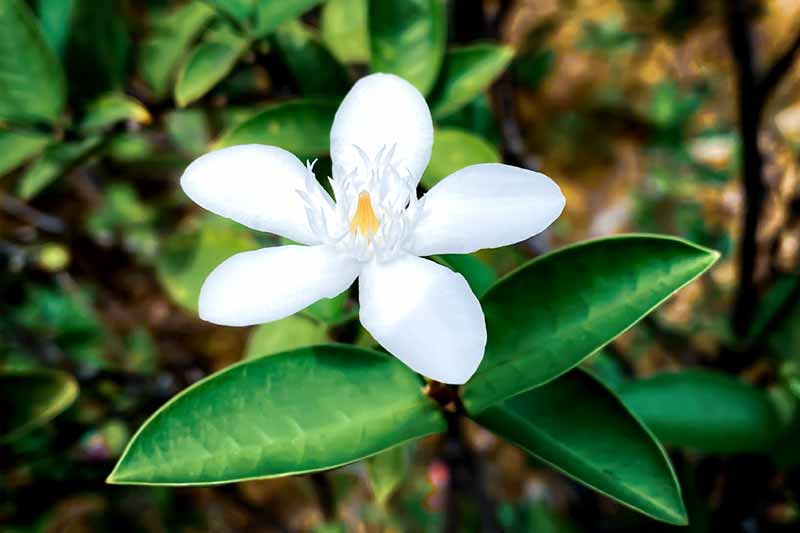Quick Facts
Botanical Name:Jasminum Grandiflorum
Family Name: Oleaceae
Common Name: jasmine oil, Royal jasmine, spanish jasmine,
Part Used: Flowers
Specific Gravity:0.92000 - 0.97500 @ 20°C
Optical Rotation:
Refractive Index: 1.47500 - 1.49500 @ 20°C
Blends Well With: sandalwood, Ylang,ylang, jasmine etc
The part of plant distilled for extracting the oil is the flowers. The origin of Jasminum grandiflorum is India and it has a mixed bouquet of sweet, sultry floral notes with elegant undertones. The extraction method is absolute and it blends well with ylang ylang, vetiver, bergamot, lemon, vanilla, sandalwood, carnation, and magnolia and neroli essential oils. The oil has many traditional, mental, physical and emotional benefits are traditionally used to treat post-partum concerns, anxiety, depression, insomnia, tension and exhaustion. The Jasminum grandiflorum oil is a very good aphrodisiac, anti-anxiety, antidepressant, astringent, tonic, emollient and depurative
Jasminum grandiflorum oil, apart from its odour is well known for ability to relax, its ability to lift depression, boosting confidence, and it ease childbirth, helps with sexual problems, soothes coughing and tones and improves skin elasticity and reduces the stretch mark and scars. The oil has a sweet, exotic and richly floral smell. Jasmine is an evergreen, delicate, climbing shrub which can grow up to 10 metres high and have dark green leaves and small white star shaped flowers. The flowers are picked in the night when the aroma is most powerful. An experienced picker can pick around 10 to 15000 flowers in a night.
Origin
The origin of the plant is China and India and later on it was brought to Spain by the Moors. France, Italy, Morocco, Egypt, China, Japan and Turkey produce the best Jasminum grandiflorum oil in the world today. The name Jasmine is derived from the Persian word 'yasmin' and it is widely used for medicinal use in China, Arabia and India and it also used as aphrodisiac and for other ceremonial purposes. The wood of the plant is sued for making rope stems in Turkey and jasmine tea is popular in China and in Indonesia it is used as a popular garnish.
Jasmine oil's first form is that of a concrete through solvent extraction and absolute is obtained from the concrete by separation with alcohol. The oil is produced off the absolute by steam distillation. 1000 lbs of flowers yield one pound of liquid concrete and from this 0.2% aromatic molecule is obtained. The constituents found in jasmine oil are many and the main ones are benzyl acetate, linalool, benzyl alcohol, indole, benzyl benzoate, cis-jasmone, geraniol, methyl anthranilate and trace maounts of p.cresol, farnesol, benzaldehyde, y-terpineol, nerolidol, isohytol, phytol, cis-3-hexenyl benzoate, eugenol, nerol, ceosol, benzoic acid, etc.

Allergic Reaction
Jasmine oil is non-toxic, non-irritant and non-sensitizing but there are people who have allergic reactions to the oil. The oil should not be used without expert opinion because of its emmenagogue properties and overdose of this oil could hinder concentration because of its calming nature. The oil is a cicatrisant, expectorant, galactagogue, parturient, sedative and uterine. It is an effective remedy in cases of severe depression and soothes the nerves and it produces a feeling of confidence, optimism and euphoria and it revitalize and restores energy. The oil speed up the birth of the child by strengthening the contractions and it also relieves pain. It is helpful in post-natal depression and promotes the flow of breast milk. The oil also helps with sexual problems like impotency, premature ejaculations and frigidity.
The oil soothes irritating coughs and helping with hoarseness and laryngitis and have a beneficial effect on the respiratory system. It helps with muscle pain, sprains and stiff limbs. The oil is good for the skin and it tones dry, greasy, irritated and sensitive skin, increase elasticity and is used to assist with stretch mark and prevent scarring. Jasminum grandiflorum oil can be used as a burner and vaporizer and in vapour therapy it can be useful for the treatment of addiction, lifting depression, easing nervousness, soothing cough, promoting relaxation and easing tension.
Widely Cultivated
It can be used as blended massage oil or in bath. It can be used as blended massage oil or diluted in the bath, for helping to break addiction, lifting postnatal depression, promoting relaxation, easing muscle pain, soothing coughs, reducing tensions, stress and nervousness. The oil can be used in a cream or lotion for dry, greasy or sensitive skin and it also help reduce stretch marks and other scars. Jasminum grandiflorum is also known as Spanish jasmine, Royal jasmine, Catalonian jasmine and this species is widely cultivated and naturalised in Republique de Guinee, the Maldive Islands, Mauritius, Reunion Java, Cook Islands, Chiapas, Central America and most part of West Indies.
In India the leaves are used in Ayurvedic herbal medicine and the flowers are used to decorate the hair of women. It is widely grown in the wild in Salt Range and Rawalpindi at 500 to 1500 m altitude. In Sri Lanka the plant is known as saman pichcha or pichcha and is widely used in Buddhist and Hindu temples. It is widely accepted as an ornamental plant and grows well in temperate and subtropical regions. Jasmine oil and concrete are used as additives in food and tobacco and the flowers are used popularly as flavouring in tea in countries like China and India.
Darkens with Age
Jasmine essential oil is a dark orange-brown viscous liquid and it darkens with age to red brown or deep red colour. Its odour is intense floral, warm and rich, highly diffusive and it has a waxy herbaceous oily fruity and tea like undertone. Light can reduce the quality of the oil like degrading of benzyl acetate and benzyl benzoate. The composition of the oil varies depending on the cultivar extracted, time of the day the flowers were plucked, age of the flower, weather conditions, season of plucking, time between plucking and extractions and extraction method and extraction solvent.
Jasmine is the major product of the flowers and it has powerful and resolute odour and is found in all types of perfumes. Attar which is made out of jasmine or the East Indian jasmine oil is prepared by water distillation of the flowers and collecting the concentrate in base oil like Sandalwood oil. Perfumed oil are produced by extracting the oil from the flowers with hot sesame or groundnut oil or by mixing the flowers with boiled sesame seed and expressing the seed oil.





